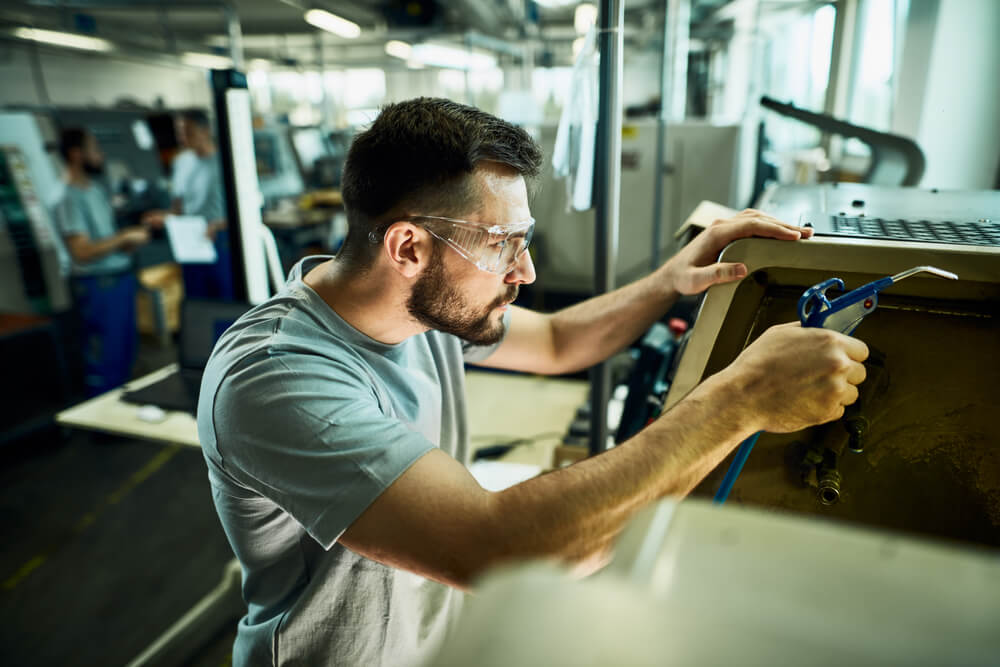Make to Order and Assemble to Order Manufacturing Workflows
Make-to-order (MTO) and assemble-to-order (ATO) are manufacturing workflows that use the pull system, meaning that production starts when an order comes in. As such, they are mostly used by companies that manufacture customizable products. In this post, we go over their differences, pros and cons, and production management considerations.
You can also listen to this article:
What is make to order?
Make-to-order, or MTO, is a manufacturing strategy in which goods are produced from scratch once an order is received. It is a “pull” type supply chain management system, meaning that production is always triggered by actual demand for goods in the form of customer orders. The main advantage of MTO is being able to produce goods to the customer’s specifications and ordered quantities, thus reducing inventory and simplifying demand planning.
MTO is contrasted with Make-to-stock, or MTS – a “push” type production strategy whereby goods are produced into finished goods inventory according to demand forecasts. Unlike in make-to-stock, order quantities in MTO manufacturing are usually much smaller and range from one to a few. Many of the components for these products may require sub-assembly before finding their way into the final product. Per unit costs for made-to-order goods are thus usually higher and lead times are longer, due to the custom-made nature of the products. This makes companies utilizing MTO more specialized and in need of larger capital investments compared to most small to medium MTS operations, though not on the level of large mass-producing MTS enterprises.
What is assemble to order?
Assemble-to-Order, or ATO, is a manufacturing strategy in which products are assembled from previously completed sub-assemblies once an order comes in. The ATO workflow is used for goods that still have some customizability but the sub-assemblies are made to stock before orders come in. Assemble-to-order is thus closely related to MTO and can be viewed as a crossway between MTO and MTS. Because it combines some customizability with competitive pricing and shorter lead times than MTO, assemble-to-order is gaining popularity in many industries.
Assemble-to-order usually requires somewhat less capital investment than MTO. This is due to not having to keep the whole manufacturing operation and supply chain in constant anticipation of incoming customer orders, as is the case with the make-to-order process. In ATO, some or even most of the sub-assemblies and components that an end product consists of, can be made to stock to await final assembly once orders arrive.
Production management considerations
Because production is triggered with an incoming customer order, both MTO and ATO usually have longer lead times than make-to-stock operations. To counter this, manufacturers employing these production strategies usually have much closer coordination with suppliers. Since manufacturing volumes are smaller, they also keep less components and raw materials in stock. This makes diligent supply chain management a must as procurements and production scheduling need to be thoroughly planned.
Whereas companies employing MTS can rely on an existing stock of finished goods to satisfy demand quickly, MTO and ATO producers usually do not keep finished goods inventory at all. A modest safety stock might be kept only in select cases, for example to anticipate sudden increases in demand for more popular SKUs. Make-to-order and assemble-to-order are excellent routes to opt for when finished goods have different customer-defined configurations or when components and raw materials are highly segregated, meaning they will only be used in specific SKUs, for a specific number of units, or per individual customer.
The trade-off between MTO and MTS has traditionally been shorter lead times vs higher customization. With growing customer demand for both higher customization and shorter lead times in a number of markets, some manufacturers are transitioning into hybrid MTS/MTO solutions. This is becoming a reality thanks to the onset of new manufacturing technologies that speed up customization, such as industrial scale 3D-printing and robotics, strategically placed decoupling points in the production line, etc. It is likely that more and more industries will see an emergence of these hybrid setups in the near future.
Video tutorial on how to manage Make-to-Order Manufacturing with MRPeasy:
Markets associated with MTO and ATO
Most companies employing MTO belong to the assembly industry like construction or industrial equipment and machinery. Together with its close relative engineer-to-order, or ETO, MTO is also the go-to solution for producing highly specialized, custom-designed, or custom-engineered goods that are usually manufactured from scratch per unit or a few units. This is mostly the case for manufacturers in high-tech, industrial equipment, vessels, aerospace, and similar industries.
ATO, on the other hand, is most common for companies that produce a base product that can be modified to a more modest extent. A good example would be the automotive sector or a personal computer, laptop, or server manufacturer. With the latter, customers can choose between many different components for a base product when making the order. Computers can have a wide range of different modules, cooling solutions, power supply units, etc., to choose from, whereas the motherboard and chassis are the same in all instances. The specific modules can be in stock awaiting final assembly after the order with the client’s custom specifications is confirmed.
Advantages and disadvantages of MTO and ATO
Main advantages of MTO and ATO include:
- More customization – In MTO and ATO, orders are made specifically to customer requirements and requests. Satisfying the customer’s particular needs is usually the main value offer of MTO and ATO companies.
- Increased efficiency – Since manufacturing is optimized to meet demand as precisely as possible in MTO and ATO, all processes that do not add value to customers are generally discarded. MTO and ATO emphasize efficiency by way of precise production scheduling and inventory optimization for a streamlined work process to keep lead times and the costs per unit in check.
- Less waste – In manufacturing, waste reduction encompasses far more than recycling scrap. Waste is also lost time, resources, and opportunities. MTO and ATO both prioritize minimizing waste by eliminating unnecessary processes, work stoppages, costs from keeping standing inventories, etc.
Main disadvantages of MTO and ATO include:
- Longer lead times, higher cost – Although not always the case, MTS operations usually have finished goods inventories, while companies utilizing MTO or ATO start manufacturing only once an order comes in. This inevitably means that delivery times for the customer’s purchases are longer. Custom products are also more expensive than goods made to stock, as economies of scale and other manufacturing optimizations do not apply.
- Complexities in the supply chain – The lead times of MTO products can stretch not only due to manufacturing per custom specification, but also because of a complex procurement process. Raw material inventories are usually kept to a minimum and components may be segregated or made to order themselves by subcontractors. MTO and ATO models need managers to have a thorough understanding and control over the supply chain to tackle this.
- Irregular sales – Whereas make-to-stock operations usually rely on demand forecasting to determine production volumes, demand for custom-made products is usually more difficult to anticipate and plan for. In addition, if an MTO or ATO operation is optimized to handle a certain workload, sudden or even anticipated increases in demand (such as from a holiday season or an upcoming Olympic Games) may be difficult to accommodate because the manufacturing setup is not optimized for mass production.
Key takeaways
- Make-to-order and assemble-to-order are manufacturing workflow modes that use the pull type supply chain management system, meaning that production is initiated through actual demand for goods.
- In make-to-order, products are made from scratch and customized to the customer’s specific requirements.
- In assemble-to-order, products are assembled from previously completed sub-assemblies once an order comes in.
- Most MTO and ATO manufacturers are found in the assembly industry, where product customization plays an important role.
- Compared to the make-to-stock production mode, lead times for MTO and ATO are usually longer, per unit price is higher, and order quantities are smaller.
You may also like: Types of Manufacturing Processes – A Comprehensive Guide





